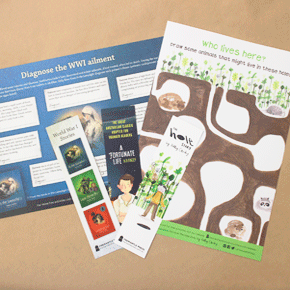Freebie Frenzy!

We’ve just taken delivery of a whole bunch of bright new bookmarks and fun activity sheets to coincide with our latest titles. There’s lots to enjoy, so grab yours now while stocks last.
To order class sets of our free merchandise, send an email to admin@fremantlepress.com.au with your name, your school’s postal address, which items you want and how many you require.
Bookmarks
Bookmarks are available for A Fortunate Life for Younger Readers by A.B. Facey, The Hole Story by Kelly Canby, In the Lamplight by Dianne Wolfer and Brian Simmonds, To the Lighthouse by Cristy Burne, Swimming on the Lawn by Yasmin Hamid and The Spectacular Spencer Gray by Deb Fitzpatrick.
Activity sheets
What kind of animals live in holes? Explore with Charlie and draw your own animals in their hole-homes in the ground. This activity features art by Kelly Canby and coincides with the release of her new picture book, The Hole Story. It is an ideal way to explore the different types of animals that live underground.
Play doctor during WWI, when antibiotics hadn’t even been invented yet and minor ailments could lead to death. This activity sheet is designed to help students understand and diagnose some of the illnesses prevalent during this period. It ties in with Dianne Wolfer’s latest picture book for older readers, In the Lamplight, which follows the story of Rose, a nurse in an Australian hospital.
Lighthouse Girl is based on the true story of Fay Howe, a lighthouse keeper’s daughter who used semaphore flags and Morse code to communicate with Australian troops on board ships bound for the war and get their messages home to their families. Fay’s unique perspective brings the moment keenly into our time, and acts as an entry point to a broader discussion on war for readers of all ages and abilities.
Morse code and semaphore were used to communicate important military information, home-front anxieties and, eventually, hopes for a more peaceful world. Click on the image below to download our Morse code classroom activity sheet.
In Flanders Fields by Norman Jorgensen and Brian Harrison-Lever tells the story of a young homesick World War I soldier who risks his life to cross the no-man’s-land and rescue a robin caught in the barbed wire that separates the opposing forces.
Its accompanying craft activity includes instructions on how to build your own periscope. Periscopes played a life-saving role in World War I for soldiers who used them to see out of the trenches. This allowed them to see the enemy without the enemy seeing them. Click on the image below to download the periscope activity.
Catalogues
With Anzac Day coming up, take full advantage of our WWI books to explore this period and the events surrounding it. New releases for 2018 A Fortunate Life for Younger Readers and In the Lamplight offer fresh views on the war. Team In the Lamplight with Dianne Wolfer’s previous books Lighthouse Girl and Light Horse Boy to explore the many different experiences of boys and girls during WWI.













